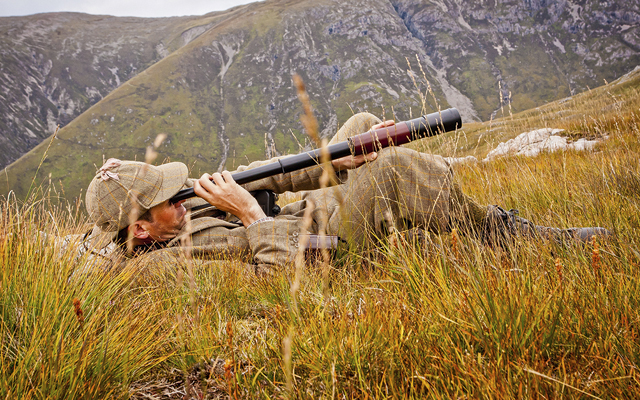From moor to plate: red deer stalking in Argyllshire
Country Life's Editor accompanies four leading chefs to Argyllshire to stalk red deer, before returning to London to learn how to cook and eat venison.


My heart’s in the Highlands, my heart is not here/My heart’s in the Highlands a-chasing the deer.’ So wrote Robert Burns in 1837, already well aware of the primeval allure of stalking red deer that continues to draw a steady stream of sportsmen to Scotland to this day.
The head chefs I was with Tim Hughes, the chef director of Caprice Holdings, which owns The Ivy (Gary Lee), Le Caprice (Andrew Mclay) and 34 (Harvey Ayliffe) had never seen a red deer, let alone shot one; however, venison is a mainstay of their menus. Ben Weatherall, owner of supplier Yorkshire Game (01748 810212; www.yorkshiregame.co.uk), decided he’d invite them to stalk their quarry to understand the extraordinary provenance of their meat.
The previous night, I’d watched the chefs prepare dinner venison, of course at the grand Victorian lodge at the Black Mount estate in Argyll and Bute, about two hours north of Glasgow. It was like watching a ballet as they floated around the kitchen at speed, never once bumping into each other.
As the morning sun slid into view, I looked across a loch to the sweeping hills. In the utter stillness, I wondered if I’d ever seen a more beautiful place than the impossibly romantic Scottish scene reflected perfectly in the water.
The kitchen maestros were resplendent in borrowed plus-twos and stockings and, after each firing a practice shot, we split into two stalking parties. One set off for the hags to the east and the factor pointed our party towards the high hills for the finer scenery. With one look at the towering Munros, I realised that my training regime of walking the terriers and striding from Waterloo station to the office every day wasn’t going to be enough. It was now unseasonably hot and, as we glassed the hills for a sight of a stag, a few of the millions of midges snacked on my ears.
We climbed for more than an hour, stopping occasionally to scan the high heather. As a breeze built up from the south, two stags were spotted at the foot of a quarry. Calum Proctor, our stalker, swapped his binoculars for a telescope and, after careful examination, pronounced that both were suitable. Stag culls are meticulously governed, both in terms of numbers killed and which individuals are taken.
The best stags are left to improve the quality of the herd. Due to the wind and the presence of some hinds, we walked away from the stags and towards a shoulder of the hill, which we climbed around so that we could come down on the beasts from above. Frogs hopped incongruously in front of me. We crossed small burns that linked arms before tumbling down a long waterfall; occasionally, grouse leapt from the heather, scolding us as they flew away.
Exquisite houses, the beauty of Nature, and how to get the most from your life, straight to your inbox.
After 5½ hours of walking uphill, we began the final achingly tense stalk. Inching into position, I hardly dared breathe. The two stags were grazing below as Calum handed me his rifle. Time stopped. I squeezed the trigger and the stag fell, dead before it hit the ground. Amazingly, the other stag stood stock still. I quickly passed the rifle to Gary and he fired, to bag us a brace of these most noble beasts.
The two stags were lying no more than 15 yards apart. They had died many miles from an abattoir, surrounded by their hills, heather and harebells. I’m sure the lack of stress they experience when they die is one of the biggest reasons why venison is so delicious.
A few days later, back in London at the kitchens of Caprice Holdings’s famous seafood restaurant, J. Sheekey (020–7240 2565; www.j-sheekey.co.uk) in St Martin’s Court, near Leicester Square, WC2, Tim explains how to make the most of this special game meat. ‘If you’re able to get hold of the prime cuts, such as the rump and the saddle, then cooking venison is very simple you just need to treat it like a fillet steak,’ says Tim, who trained with Marco Pierre White and has been a culinary force of nature at Caprice Holdings for the past 15 years. A healthy choice because it’s so lean, venison also demands respect because the lack of fat makes it easy to overcook. Other cuts, such as the haunch, shank, shoulder and legs, should be braised and cooked slowly.
‘Venison can take earthy, hearty flavours it works especially well with fruit,’ continues Tim, as he deftly cuts the deep-pink fillet and explains why it was so important for him and his team of chefs to see where their meat comes from. ‘We’ve been writing Black Mount venison on the menu for years, but now we’ve been there. Having an appreciation of the effort it takes to stalk, shoot and bring an animal down off the hill was a great experience for us all.’
It might be 8am, but the kitchens at J. Sheekey are already preparing for the lunch service as Andrew and Tim set about cooking roast fillet of venison with haggis, bashed neeps and elderberries (see recipe, page 82), currently on the menu at Le Caprice (020–7629 2239; www.le-caprice.co.uk) in St James’s, SW1.
Having cut the venison into a 5in chunk, Tim sears it on all sides for three to four minutes before leaving it to rest while he makes the sauce. ‘You want something sweet to go with the meat,’ he tells me. ‘Figs, apples, rowan berries, crab-apple jelly, pears, quince and nuts are all perfect.’ Indeed, chestnuts and caramelised figs featured on another venison dish at Le Caprice earlier this year, this time with loin steaks; cobnuts and pickled pears grace an elegant peppered venison salad now available at The Ivy (020–7836 4751; www.the-ivy.co.uk) in Covent Garden, WC2; and sweet baby beetroots enhance the flavour of the roasted loin that’s on the menu at 34 (020–3350 3434; www.34-restaurant.co.uk) in Mayfair, W1.
For an exceptional sauce, roast off the trimmings and bones with garlic and red wine to create a delicious stock that can be passed through a sieve and then added to the fruit, nuts or mushrooms that accompany your dish. Tim also recommends flash-frying kale or cabbage in butter to serve alongside the venison ‘just don’t knacker it by cooking it for so long that it’s mushy and tasteless,’ he warns.
Tim is a huge fan of venison he likes roe, red and especially muntjac, which has a later season and can’t understand why it’s not more popular with home cooks. ‘It’s great that more supermarkets are beginning to stock it,’ he admits. ‘But I rate it higher than fillet of beef. It has a greater depth of flavour and you can do so much more with venison fillet.’
For further information about stalking on Black Mount or Glen Etive, contact Helen Polley at Bidwells (01397 702433; helen.polley@bidwells.co.uk)
Tim Hughes’s roast fillet of venison with haggis, bashed neeps and elderberries (serves 4) The gaminess of venison depends on how young it is or how long it’s been hung. When it’s really fresh and young, it can taste like beef, so you may wish to marinate it. Red wine, crushed juniper berries and thyme leaves are really all it needs for an overnight marinade. Elderberries aren’t usually available in the shops, so you’ll need to find a tree. Otherwise, you could replace them with redcurrants or any other small berries frozen ones will be fine, as they’re going into the sauce.
Ingredients
For the venison 4 150g trimmed venison saddle fillets 100ml good-quality red wine 6 juniper berries, crushed A few sprigs of thyme, chopped Sunflower oil for cooking Salt and freshly ground black pepper
For the sauce 150ml beef or game stock (a low-salt stock cube will do, or fresh gravy, made or bought) 50g elderberries 30g unsalted butter
For the bashed neeps 150g Blackface haggis (scooped out of its casing) 250g carrots, peeled and roughly chopped 250g swede, peeled and roughly chopped 50g unsalted butter Salt and freshly ground black pepper
Method The day before, put the venison into a stainless steel or china dish. Add the wine, juniper and thyme; mix well, cover and marinate overnight in the fridge. On the day, put the carrots and swede into a saucepan; cover with water and season. Bring to the boil and simmer gently for 15 to 20 minutes, until the vegetables are soft enough to mash. Drain and coarsely mash with a potato masher. Add haggis, butter and black pepper and mix well over a gentle heat. Check the seasoning. Keep warm on the side.
Remove the venison from the marinade, retaining the liquid. Pat the fillets dry with kitchen paper and season with salt and black pepper. Heat oil in a heavy-bottomed frying pan and cook the fillets for 2–3 minutes on each side for medium rare or 3–4 minutes for medium. Leave to rest on a warm plate to catch the juices. Meanwhile, boil the marinade rapidly in a saucepan until it’s reduced to about a tablespoon.
Add the gravy and any juices from the venison and simmer for a minute or so, until the sauce has thickened, then strain through a sieve. Return to the pan, add the elderberries and butter and stir until the butter has emulsified.
Reheat the neeps and spoon into the centre of the plate. Slice the venison and arrange on the neeps, then pour the sauce around it.
The haggis used in this recipe is from Mr Weatherall’s The Blackface Meat Company (01387 730326; www.blackface.co.uk). For three more venison recipes from 34, The Ivy and Le Caprice, go to www.countrylife.co.uk
Mark grew up in the Cotswolds and began his career as a gold prospector. He became editor-in-chief of Country Life in 2006, having previously been in charge of more than 50 magazines, including Horse & Hound. He attributes his success to David Bowie and fly-fishing.
